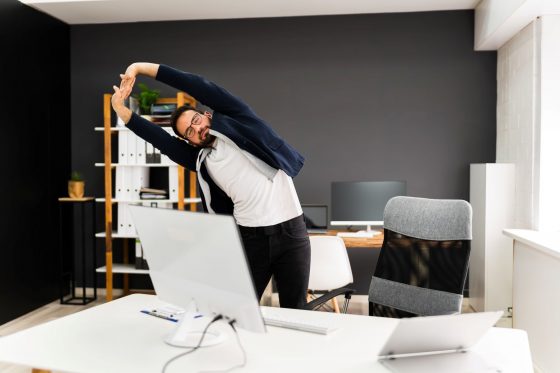A registered massage therapist and ergonomist share their tips to work comfortably and reduce the risk of injury while working at a desk.

Photo credit: istock.com/AndreyPopov
Working at a desk may seem like a low-risk activity, compared with other kinds of work, but even sitting for long periods can lead to muscle pain.
Recently, I read that regular activity helps prevent heart disease, type 2 diabetes, and other illnesses linked with prolonged sitting. The Canadian Occupational Safety article, ‘The dangers of sedentary work’ says that taking regular “fit breaks” can benefit our psychological and physical health.
Get up and move
I contacted my friend Barbara Bourne, a registered massage therapist, to find out more about what people might experience from long periods of desk work. She said it’s common for hip flexor muscles to shorten if we don’t get up and move enough. She explains that in some cases, shortened hip flexors can lead to lower back pain. (Hip flexors are at the very tops of our legs, where muscles attach to hip bones, just below the belt buckle.)
“When I tell people to do hip flexor stretches to help with lower back pain, sometimes they roll their eyes at me,” says Barb, with a laugh. The connection between the two aren’t always obvious. She adds, “If you have pain between your shoulder blades, stretching your chest muscles can help. Sometimes you hurt in the back, but you have to stretch in the front.”
Barb also encourages drinking water. It’s not just to stay hydrated. “If you drink a lot of water while you’re working, you’ll be motivated to move by your bladder – and boy, is that good motivation!”
She suggests setting a timer to remind yourself to stand up and move, whether you’re working at home or in an office.
Stretching, vision, and posture
While you’re moving, don’t forget about your eyes. Every 20 minutes, take a 20-second stretch break and look 20 feet away,” says Emma Christensen, a corporate ergonomist with WorkSafeBC’s Safety, Health, and Wellness department.
Emma offered more advice in my post How does vision affect posture? One of her key points was that “It doesn’t matter if you have a fancy office chair or height-adjustable desk. If you can’t see, you’re going to lean forward and have bad posture.”
She recommended that people with progressive lenses keep their monitors low enough so that they can see through the lower section of their lenses while keeping their neck straight.
For other practical suggestions to help achieve correct posture and reduce the risk of injury while working at a desk, see the resource ‘Setting up, organizing, and working comfortably in your home workspace’, from WorkSafeBC. It provides practical suggestions on setting up your workspace, organizing the area, and working comfortably at home.
Do you have tips on taking care of the body while sitting for work? Please share them below.


